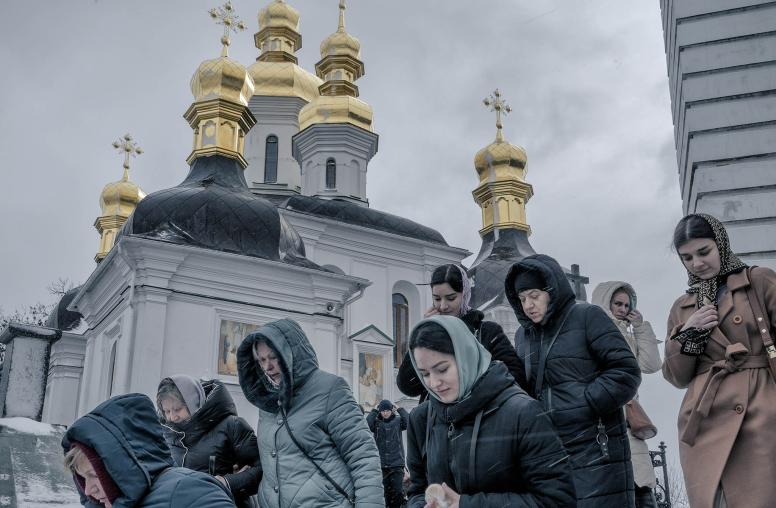How Russia May Reprise Its Syrian Playbook in Ukraine
From its goal of a post-West world to a strategy of civilian terror, Moscow’s war in Europe echoes its Middle East intervention.
The tragic patterns set in Russia’s brutal war in Syria are unfolding anew in Ukraine. Already, chilling parallels are evident between Moscow’s prosecution of the Syrian conflict and its current conduct in its Eastern European neighbor. Going forward, Russia’s Syrian playbook may provide additional insights into its approach to diplomacy as well as how Russia now envisions its eventual Ukrainian endgame.

Ukraine Isn’t Syria
Significant differences distinguish Russia’s current engagement in Ukraine from its 2015 intervention in the Syrian civil war. Moscow joined the Syrian conflict at the behest of the Assad regime, which was threatened with collapse at the hands of a strengthening Islamist insurgency. Russia’s primary objective was to prevent the fall of yet another Arab regime in the wake of the 2011 Arab uprisings. It was largely an opportunistic move requiring a relatively small investment of blood and treasure for a mission far from Russia’s near abroad. Its engagement in Syrian airspace was largely uncontested and it relied on others—primarily Iranian-backed militias—to fight the ground war. From Russia’s perspective, the battle in Syria offered potentially high returns for a relatively low cost.
By contrast, Russia initiated its brutal war of aggression against Ukraine in pursuit of regime change. Moscow has depicted the stakes in Ukraine as nothing less than existential, imbuing it with the utmost strategic importance. Yet four weeks into the assault, Russia has confronted staunch opposition from Ukrainian forces fighting what some call a “war of rare clarity” that has captured the hearts of much of the world, galvanized NATO and deepened European resolve against Moscow. Russian President Vladimir Putin’s strategic miscalculation has thrust Russia into a high-cost gambit with little prospect of achieving his ambitious goals.
Russia’s “Post-West Order” Framing
The underlying drivers, stakes, and objectives in Syria and Ukraine are strikingly different. Yet, elements of Russia’s framing, tactics, strategy, and endgame in Syria are reflected in Ukraine. Russian analysts and academics have described Syria as Russia’s “first post-Soviet success.” In this view, Russia’s relatively successful engagement in Syria served as a test case for a new, “post-West” order. For Moscow, this multipolar, post-West world is marked by the erosion of the U.S.-led international order and weakened U.S.-led multilateral institutions, including NATO.
In recent discussions, Russian academics confirmed that this vision of a post-West order underlies Russia’s war in Ukraine. Indeed, its invasion of Ukraine underscores Putin’s flagrant disregard of the rules-based international order in pursuit of his revanchist aims to re-establish a Russian empire. Russia’s willful—and largely unanswered—disregard of international humanitarian law throughout the Syrian conflict conveyed to Moscow an air of impunity that has defined its conduct in the early weeks of the war against Ukraine. In Syria, Russia also sought to drive a wedge between Turkey and its NATO allies with its pursuit of Turkish cooperation and its sale of the S-400 missile system to Ankara. In its assault on Ukraine, Russia mistakenly calculated that it could divide NATO.
Brutal Battlefield Tactics
Fighting alongside the Assad regime, Russia broadly disavowed international law, which seeks to minimize civilian harm in conflict and ensure that lifesaving humanitarian aid reaches those in need. The list of Russian transgressions in Syria is long, and several of these violations are already occurring in Ukraine. Some of these tactics were initially honed in Chechnya, but Russia further developed its playbook to address the Syrian conflict’s scale and complexity.
- Widespread attacks on civilian targets. Russia, together with the Syrian regime, regularly targeted hospitals, medical facilities, schools, and residential neighborhoods. Journalists and human rights groups have documented nearly 70 instances of Russian and Syrian forces hitting designated “no strike” sites; the actual number is surely far higher. Already, Russia’s indiscriminate targeting of civilians has become a regular feature of the war in Ukraine.
- Deliberate targeting of a UN humanitarian convoy. A September 2016 Russian attack hit a UN convoy attempting to deliver aid to a besieged part of Aleppo, killing at least 20 people.
- Besieging population centers. To starve towns into submission, Syrian and Russian forces would encircle strategic areas, cutting off all assistance and shelling indiscriminately. Such besiegement tactics were used to overtake eastern Aleppo as well as the Damascus suburbs including east Ghouta. Some areas were besieged for as long as four years. Similar “surrender or starve” tactics are now in play in Ukraine in areas such as Mariupol. Relief workers estimate that 12 million Ukrainians currently live in besieged or heavily conflict-affected cities.
- “Double tap” airstrikes. Russia stands accused of undertaking a “double tap” strike in Idlib, hitting a target and then circling back and hitting it again when first responders arrive.
- Use of proscribed weapons. Russia reportedly has used cluster munitions in Syria and in one alleged instance, struck a target with a thermobaric bomb. Russia is accused of using both in Ukraine.
- Employing chemical weapons. Perhaps the most dangerous transgression of international law in Syria concerns the use of chemical weapons which preceded Russia’s entry into the conflict. Sarin and chlorine gas were used with disturbing regularity as a weapon of terror to force civilians to surrender and leave or to terrorize and punish them. After Russia intervened in Syria, the use of chemical weapons continued. In 2017, for example, the Assad regime attacked an opposition-held area with Sarin gas. Russian disinformation soon followed, falsely accusing the Syrian opposition of undertaking the attack. While chemical weapons have not been used in Ukraine to date, this is precisely the scenario that many fear could unfold.
Instrumentalizing Diplomacy
As the war in Ukraine deepens and various diplomatic and humanitarian initiatives are launched, Russia’s conduct in Syria again becomes relevant. Throughout its engagement in Syria, Moscow often exploited diplomatic efforts aimed at calming the fighting to further its military goals on the ground. In 2017, for example, with the establishment of so-called “de-escalation zones,” Russia would selectively respect some of these zones while violating others depending on its military goals. Indeed, Russian forces would exploit the calm in one such zone to double down on the fighting in another. Similarly, humanitarian corridors and local ceasefires were often violated or exploited to achieve tactical gains on the ground.
Weaponizing Displacement
The strategy of the Assad regime’s war in Syria was as much about displacement and “demographic re-engineering” as it was about killing, leaving more than half of Syria’s pre-war population displaced internally or as refugees. It was the most significant displacement crisis since the end of World War II — until Russia’s war on Ukraine began. The Assad regime—enabled by Russia—used forced displacement and ethnic cleansing to force large swathes of the population opposed to Assad into an ever-shrinking corner of northwest Syria or outside the country altogether.
Russia, too, appears to be weaponizing displacement in Ukraine. Just four weeks into the conflict, almost 4 million Ukrainians have fled as refugees to other countries, while an estimated 6.5 million are displaced internally, together accounting for more than a quarter of the population. This pace of displacement far outstrips that of the Syrian conflict. And as in Syria, Russia appears to be adopting of strategy of terrorizing civilians to force their displacement and thereby seize territory.
Same endgame?
Russia intervened in Syria with the goal of propping up the Assad regime and regaining all Syrian territory lost to opposition elements. However, they were unable to achieve their maximalist aims. Their prosecution of a brutal war in Syria has yielded unspeakable levels of human suffering and physical destruction. Yet nearly seven years into its intervention, Russia has had to settle for a divided Syria that is unstable, fractured, and deeply impoverished. For Russia, this somehow constitutes a victory.
As Moscow lays siege to Ukraine, demanding its capitulation and refusing to contemplate its own withdrawal, the conflict’s trajectory may place it on the path of similar endgame, namely a divided Ukraine. Ukraine’s military intelligence chief recently warned that Putin plans to split Ukraine in two. He compared that prospect to the division of North and South Korea.




